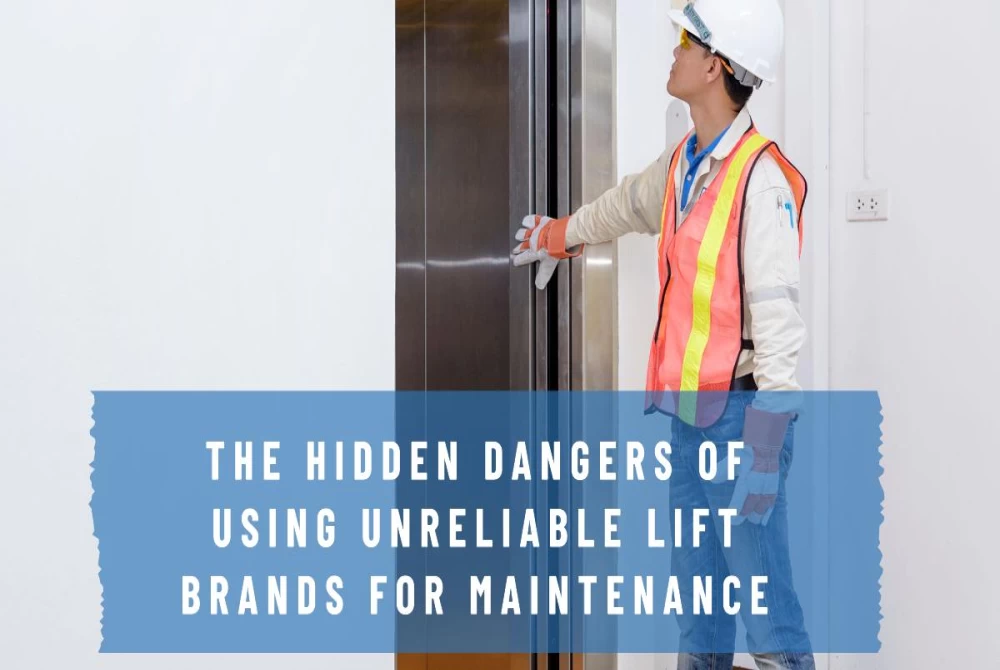
- Published 25 December, 2024
The Hidden Dangers of Using Unreliable Lift Brands for Maintenance
Using unreliable lift brands for maintenance can be risky and lead to many problems. These lifts may seem cheaper, but they can put people and equipment in danger.
We as one of the best Lift manufacturers in Delhi are here to help you make smarter choices for safety and reliability.
Safety Risks
- Cheap lifts often use weak materials that can break easily.
- Faulty designs may cause the lift to malfunction unexpectedly.
- Accidents like lift drops or sudden stops can happen.
- People using the lift may get injured if it fails.
- The risk is higher if the lift is carrying heavy loads.
- Lack of safety features can make these lifts more dangerous.
- Unreliable lifts may not pass safety tests or inspections.
- Maintenance workers are also at risk when using unsafe equipment.
Frequent Breakdowns
- Cheap lift brands often use low-quality parts that wear out quickly.
- The lifts may stop working without warning during operation.
- Frequent breakdowns can cause delays in work schedules.
- Repairs for unreliable lifts can be expensive and time-consuming.
- Lack of proper testing means these lifts fail more often.
- Overuse of weak parts increases the chances of failure.
- Breakdowns may require emergency repairs, adding stress and cost.
- The downtime affects productivity and overall efficiency.
Low Load Capacity
- Unreliable lifts often cannot handle heavy loads safely.
- Exceeding the lift’s capacity may cause it to collapse.
- Weak materials can bend or break under pressure.
- Load limits may be unclear or inaccurate in poor-quality lifts.
- Overloading can damage the lift’s internal parts, leading to failure.
- Lifts with low capacity are not suitable for demanding tasks.
- Workers may risk injury if the lift fails while carrying heavy loads.
- Equipment or goods on the lift could also get damaged.
Poor Build Quality
- Unreliable lifts are often made with cheap, weak materials.
- Poor construction causes parts to wear out or break quickly.
- Weak welds or joints can fail under pressure or movement.
- The lift may develop rust or cracks faster than quality brands.
- Low build quality reduces the overall lifespan of the lift.
- Vibrations or uneven movement can happen due to poor design.
- Faulty components make the lift unsafe for workers and loads.
Inaccurate Operation
- Unreliable lifts may not move smoothly, causing jerks or stops.
- The lift could tilt, making it unsafe for workers or loads.
- Poor controls may lead to wrong or delayed responses.
- Inaccurate operation can cause misalignment during lifting or lowering.
- This may damage equipment, or the load being moved.
- Faulty sensors might give incorrect weight readings.
- Workers may struggle to operate the lift safely and efficiently.
- The risk of accidents increases when the lift doesn’t work correctly.
No Certification
- Unreliable lifts often lack proper safety certifications.
- Certification ensures the lift meets safety and quality standards.
- Without certification, there’s no proof the lift is safe to use.
- Unsafe designs or materials may be used in uncertified lifts.
- Workers and equipment are at higher risk of accidents.
- Certified lifts are tested for performance under different conditions.
- Using uncertified lifts might violate workplace safety rules.
- This could lead to fines or legal problems for the company.
Limited Spare Parts
- Unreliable lift brands often have limited availability of spare parts.
- Finding replacement parts can be difficult and time-consuming.
- Some parts may be out of stock or discontinued.
- This makes repairs take longer, leading to longer downtime.
- Using incorrect or generic parts can reduce the lift’s performance.
- Lack of spare parts can increase repair costs over time.
- Technicians may struggle to find the right components.
High Maintenance Costs
- Unreliable lifts often need frequent repairs, which can be costly.
- The quality of parts used in cheaper lifts means they wear out quickly.
- Ongoing repairs can quickly add up to a high total cost.
- Low-quality lifts may break down more often, leading to downtime.
- Repairs take longer if parts are hard to find or expensive.
- Replacing damaged parts regularly increases overall maintenance costs.
- Without proper maintenance, the lift may become unsafe to use.
- Constant breakdowns lead to lost productivity and higher costs.
Lack of Warranty
- Unreliable lift brands may not offer a proper warranty.
- Without a warranty, you’ll have to pay for all repairs yourself.
- A lack of warranty means no support if the lift breaks down.
- If the lift has a major problem, it could be very costly to fix.
- Poor-quality lifts are more likely to need repairs, increasing costs.
- Some brands only offer limited or no warranty at all.
- A good warranty by Dumbwaiter lift manufacturers in India covers repairs and part replacements for a certain time.
Legal and Insurance Issues
- Unreliable lifts may not meet legal safety standards.
- Using unsafe lifts could violate workplace safety laws.
- If the lift causes an accident, the company could face fines or lawsuits.
- Insurance may not cover accidents caused by faulty lifts.
- Using uncertified lifts can lead to insurance claims being denied.
- Without proper documentation, repairs or damages may not be reimbursed.
- Legal issues can increase the company’s costs and damage its reputation.
